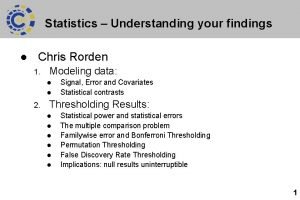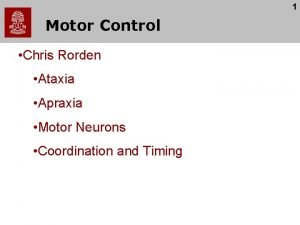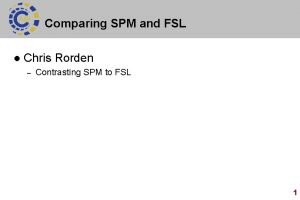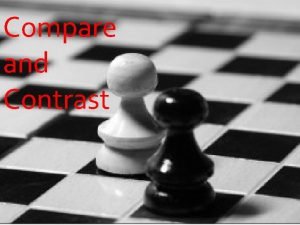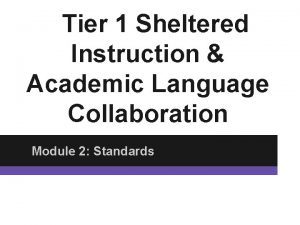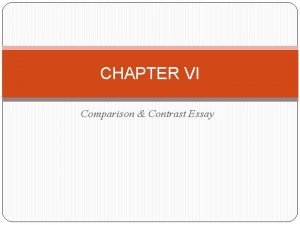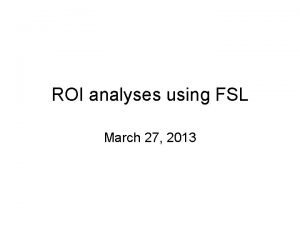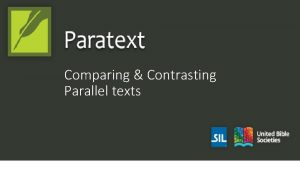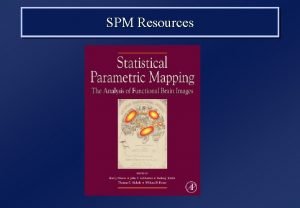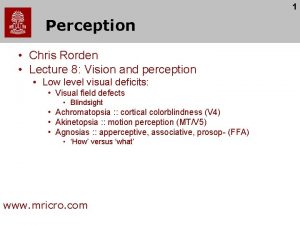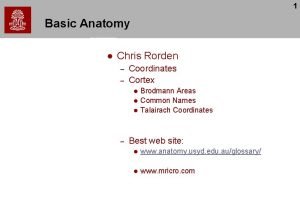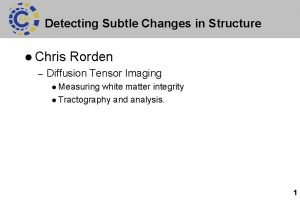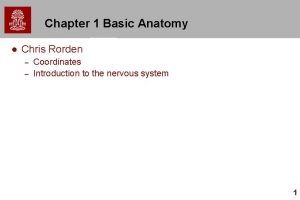Comparing SPM and FSL l Chris Rorden Contrasting













- Slides: 13

Comparing SPM and FSL l Chris Rorden – Contrasting SPM to FSL 1

FSL vs SPM 5 l We have focused on FSL – – l SPM is the most popular tool – l Completely free Allows students to get a feel for f. MRI analysis Free, but requires Matlab to run Here we contrast these tools 2

FSL 3. 3 vs SPM 5 Motion Correction FSL l Motion Correction l Slice Timing Correction Normalization Smoothing Individual Statistics Normalization Group Statistics Typical f. MRI processing pipeline is similar. In FSL, normalization is done after initial statistics. l Allows you to see activation on original raw scans. l Faster, as we usually super sample images during normalization (i. e. increase field of view and resolution). 3

Motion Correction (=realignment in SPM) l l l Both SPM and FSL use rigid body registration. Different cost functions are used (SPM: variance; FSL: Normalised Correlation). By default, SPM aligns all images to first 4 D volume, while FSL aligns to the middle 4 D volume. Optionally, SPM can ‘realign and unwarp’ which attempts to correct head motion related changes in image intensity (see spatial processing lecture). – – – FSL’s optional solution is to add motion parameters to statistical model (the Stats tab of FEAT). SPM’s solution more sophisticated, but time consuming. Both techniques can reduce noise, but will reduce power if head motion correlates with task (e. g. head moves with button presses). 4

Slice Timing Correction l Slice Timing Correction attempts to make all slices in a 3 D volume appear as if they were collected simultaneously (see temporal processing lecture). – l l Dilemma: required but inaccurate for long TR, accurate but not influential with short TR. SPM and FSL use the same algorithm. By convention, most SPM users employ STC for event related designs, while FSL users do not. We are fortunate to have a scanner that can provide full brain coverage with a short TR. Therefore, I would use a rapid (~2 sec) TR for event related designs and not use STC. 5

Smoothing During the ‘smoothing’ stage, both FSL and SPM apply a spatial smoothing. l FSL also applies a 100 s highpass temporal filter to remove low frequency artefacts. l – – SPM’s temporal filtering occurs during the individual statistics stage, with a default 128 s highpass. For both tools, a low pass filter is optional, and can help block designs. 6

Normalization align’s the individual’s brain to stereotaxic space (warping the orientation and size), allowing comparison between people. l SPM and FSL have very different approaches to normalization. l In general, FSL is very robust (always approximately right), but pretty constrained (there tends to be a lot of residual error). l SPM is very aggressive, and can do better than FSL in ideal circumstances (i. e. good data). l 7

Normalization Two competing approaches for normalization (found both in SPM and FSL): l – Direct normalization: 1. – Indirect normalization: 1. 2. 3. l Normalize T 2* f. MRI data directly to stereotaxic space Coregister T 2* f. MRI data to T 1 scan Normalize high resolution T 1 to stereotaxic space Use parameters from step 2 to normalize f. MRI data to stereotaxic space The second approach is better in theory. However, it does require a good structural scan, and has more chances to fail catastrophically. 8

Normalization l FSL uses FLIRT (FMRIB's Linear Image Registration Tool) to normalize – – – l Only linear normalization. By default, direct normalization uses a T 1 template image, so a between-modality (correlation ratio) cost function is used. FSL’s analysis of DTI data uses a non-linear registration tool (IRTK), but this is not typically employed for f. MRI data. SPM’s normalization initially uses linear transforms, and then applies non-linear transforms. – By default, direct normalization uses a T 2* template, so a variance cost function can be applied. 9

Normalization l SPM 5 introduces a very aggressive indirect normalization. – – – The T 1 scan is bias corrected and segmented to gray matter, white matter and CSF probability maps (see VBM lecture). Warping these tissue maps to standard space can provide more accurate normalization (as non-brain tissue does not influence parameters). FSL does ‘skull strip’ data for normalization, but this is more constrained than SPM’s method. 10

Individual Statistics SPM and FSL apply general linear model to data l SPM models HRF using double gamma function (blue); by default, FSL uses a single gamma function (red). l Both include temporal derivatives (turn these off for block designs) l SPM and FSL have different approaches for autocorrelation – see the temporal processing lecture. 11

Group statistics l l FSL uses estimates of each individuals’ contrast parameter estimates (copes) and variability (varcopes), SPM only uses estimates of contrast. (see statistics lecture). In theory, FSL might be a bit more sensitive. In practice, it is much slower. Z stats Group copes varcopes Sub 1 Sub 2 Sub 3 Sub 4 12

Learning SPM 5 comes with an excellent manual l Chapter 25 walks you through analysis of a block design. l Chapter 26 guides you through the analysis of an event-related design. l 13
 Chris rorden
Chris rorden Chris rorden
Chris rorden Chris rorden
Chris rorden Fsl vs spm
Fsl vs spm Comparing and contrasting hinduism and buddhism
Comparing and contrasting hinduism and buddhism What is the definition of compare and contrast
What is the definition of compare and contrast Karina is writing a paragraph comparing and contrasting
Karina is writing a paragraph comparing and contrasting Karina is writing a paragraph comparing and contrasting
Karina is writing a paragraph comparing and contrasting Comparison and contrast signals
Comparison and contrast signals Compare and contrast colonial regions
Compare and contrast colonial regions Let's practice text structures
Let's practice text structures Chris and jenny are comparing two similar punch recipes
Chris and jenny are comparing two similar punch recipes Fsl blaze
Fsl blaze Fsl roi analysis
Fsl roi analysis
